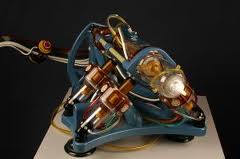Biopsy Robots
Biopsy Robots

Biopsy Robots. Researchers believe that some routine medical procedures such as breast and prostate biopsies could be performed in the future with minimal human guidance at less cost and greater convenience to patients.
Already, the Johns Hopkins Urology Robotics Lab based in Baltimore, Maryland are working on biopsy robots and have developed a medical robot called the PneuStep that can carry out organ biopsies during an MRI scan. The robot is powered by a motor that uses no metal or electricity, operating only on the intense magnetic fields generated by the Magnetic Resonance Imaging machines. The incredible robot is made of "plastics, ceramics and rubber" and is “driven by light and air,” meaning, a series of pistons and gears controlled by a computer in another room.
Far more precise than the mechanisms employed used to remove tumors, the PneuStep could significantly improve the treatment of prostate cancer, which is apparently almost impossible to spot outside of an MRI machine. Before this, surgeons usually relied on "blind" biopsies when operating on organs like the prostate.
Researchers are positive that soon, unassisted one-stop breast exams and biopsies will be available for women. This means that after woman gets a mammogram and anything suspicious is found, an actual robot could be used to guide a needle to the spot to extract a tissue sample.
Duke University researchers are presently working on biopsy robots that can perform this breast biopsy. So far, the human-assisted experimental robot has successfully demonstrated its abilities, throwing open the doors to robotic uses in the medical field even wider.
Ned Light, an engineer explains in an article by the Duke University Office of News and Communication, “Engineers used a basic tabletop robot with ‘eyes’ that used a 3-D ultrasound technology from Duke. An artificial intelligence program comprising the robot’s ‘brain’ processed the 3-D information and gave the robot tasks to perform. After detecting the ‘lesion’ in a simulated breast, the robot was able to calculate its position and then guide a biopsy to its exact location.”